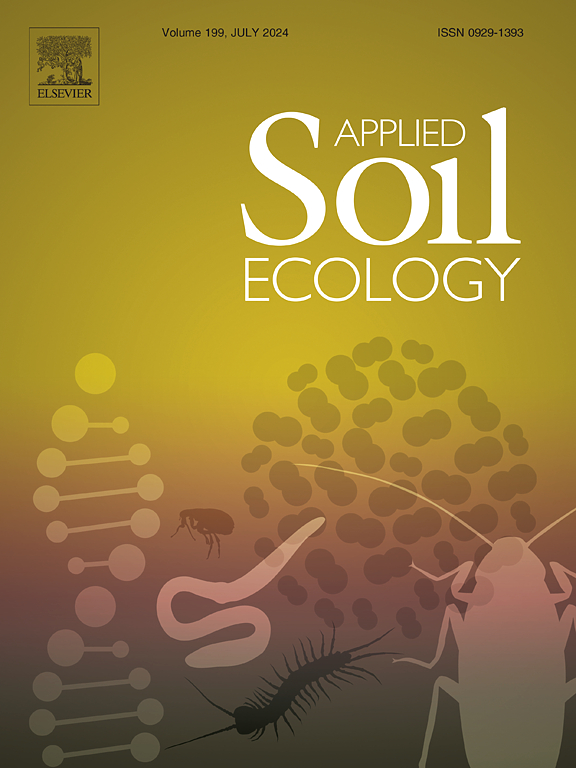Comparing soil microarthropod communities derived directly from soil DNA metabarcoding with those from morphological assessment in a drought-prone and irrigated pine forest
IF 4.8
2区 农林科学
Q1 SOIL SCIENCE
引用次数: 0
Abstract
Springtails (Collembola) and mites (Acari) are soil microarthropods, one of the most diverse animal groups in soils. They play a crucial role in organic matter cycling and are active throughout the food web as decomposers, bacterivores, fungivores, and carnivores. Only little is known about how these groups might respond to shifts in water availability, for example in the context of global change. Here, we investigated how soil microarthropods responded to long-term irrigation in a drought-prone Scots pine (Pinus sylvestris) forest in southern Switzerland. After more than a decade of doubling the annual rainfall, irrigation improved not only tree vitality but also soil quality, and with shifts in bacteria and fungi reflecting changes from oligotrophic to copiotrophic conditions. We assessed soil microarthropods with two approaches: (1) directly by soil DNA metabarcoding and (2) by morphological assessment after extraction of the animals with Macfadyen funnels. Another main aim of that study was to compare the results with the two approaches. The dominant Collembola genus in both assessment approaches was Parisotoma. The dominant Sarcoptiformes genus was Oppiella whereas Geolaelaps was the dominant Mesostigmata genus in both assessment approaches. Only the metabarcoding approach detected Trombidiformes genera, and only one genus, Microtydeus, had a classification confidence >80 %.
The abundance and alpha-diversity of Collembola and Acari did not change significantly as a result of the irrigation treatment, regardless of the assessment approaches applied. In contrast, microarthropod beta-diversity showed significantly shifts for Collembola and Acari, and for the Collembola order Entomobryomorpha and the Acari orders Sarcoptiformes, Mesostigmata, and Trombidiformes. A Procrustes analysis comparing the two assessment approaches indicated a significant effect of the irrigation treatment for the mite order Sarcoptiformes and a nearly significant effect for Collembola.
Using indicator species analysis a Parisotoma species was the only Collembola taxon in the metabarcoding assessment that was strongly associated with the irrigation treatment. With the morphological assessment, Parisotoma notabilis and Lepidocyrtus sp. were significantly associated with irrigation. For Acari, only the morphological approach let to Licnodamaeus pulcherrimus as a negative indicator taxon for irrigation. By using the morphospecies lists as a reference for validation and comparing it with the species list obtained through metabarcoding, we found that only a small percentage of Collembola and Acari morphospecies overlapped. The metabarcoding approach detected taxa that were not observed with the morphological assessment, such as Neelipleona, Symphypleona, or Trombidiformes. Due to the complexity of the taxa and the lack of comprehensive taxonomic identification and reference databases, identification at the species level is hardly possible. Further efforts to enrich the microarthropod reference database are urgently needed.

比较干旱和灌溉松林土壤微节肢动物群落与土壤DNA元条形码分析结果
弹尾虫(弹尾虫)和螨(蜱螨)是土壤微节肢动物,是土壤中最多样化的动物类群之一。它们在有机物循环中起着至关重要的作用,在整个食物网中作为分解者、细菌食者、真菌食者和食肉动物活跃。对于这些群体如何应对水资源供应的变化,例如在全球变化的背景下,人们知之甚少。在这里,我们研究了土壤微节肢动物对瑞士南部干旱易感的苏格兰松林(Pinus sylvestris)长期灌溉的反应。十多年来,年降雨量翻了一番,灌溉不仅改善了树木的活力,还改善了土壤质量,细菌和真菌的变化反映了从贫营养到共生营养的变化。本文对土壤微节肢动物进行了两种评价方法:(1)土壤DNA元条形码法和(2)麦克法迪恩漏斗提取后的形态学评价。该研究的另一个主要目的是比较两种方法的结果。两种评估方法的优势弹虫属均为Parisotoma。在两种评价方法中,肢形目的优势属均为Oppiella,而中形目的优势属为Geolaelaps。元条形码法仅检测到恙螨属,其中只有小蚊属的分类置信度为80%。无论采用何种评价方法,灌水处理对线虫和蜱虫的丰度和α -多样性没有显著影响。微节肢动物β -多样性在弹虫目和蜱螨目、虫形目和虫形目、中形目、恙螨目中表现出明显的变化。Procrustes分析比较了两种评价方法,结果表明灌溉处理对螨目肉形虫有显著的效果,对线虫有接近显著的效果。指示种分析表明,在元条形码评价中,唯一与灌溉处理密切相关的弹虫属是Parisotoma种。形态分析表明,异异瘤和鳞翅目鼠与灌溉有显著的相关性。对蜱螨来说,只有形态上的分析才认为Licnodamaeus pulcherrimus是灌溉的阴性指示分类群。以形态种列表作为验证参考,并与元条形码获得的物种列表进行比较,我们发现弹尾虫和蜱螨只有一小部分形态种重叠。元条形码方法检测到形态学评估未观察到的类群,如Neelipleona, Symphypleona或Trombidiformes。由于分类群的复杂性和缺乏全面的分类鉴定和参考数据库,在物种水平上进行鉴定是不可能的。迫切需要进一步努力丰富微型节肢动物参考数据库。
本文章由计算机程序翻译,如有差异,请以英文原文为准。
求助全文
约1分钟内获得全文
求助全文
来源期刊

Applied Soil Ecology
农林科学-土壤科学
CiteScore
9.70
自引率
4.20%
发文量
363
审稿时长
5.3 months
期刊介绍:
Applied Soil Ecology addresses the role of soil organisms and their interactions in relation to: sustainability and productivity, nutrient cycling and other soil processes, the maintenance of soil functions, the impact of human activities on soil ecosystems and bio(techno)logical control of soil-inhabiting pests, diseases and weeds.
 求助内容:
求助内容: 应助结果提醒方式:
应助结果提醒方式:


